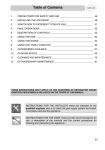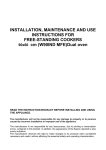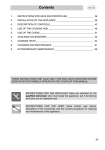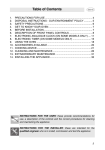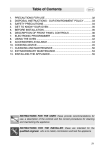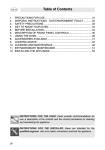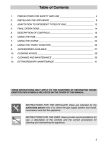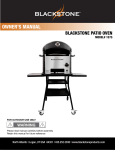Download Smeg CS19ID-6 cooker
Transcript
Index 1. PRECAUTIONS FOR SAFETY AND USE _____________________ 36 2. INSTALLING THE APPLIANCE _____________________________ 38 3. DESCRIPTION OF CONTROLS ____________________________ 40 4. HOB __________________________________________________ 47 5. USING THE OVEN _______________________________________ 52 6. ACCESSORIES AVAILABLE _______________________________ 53 7. COOKING ADVICE ______________________________________ 54 8. CLEANING AND MAINTENANCE ___________________________ 62 9. EXTRAORDINARY MAINTENANCE _________________________ 65 INSTRUCTIONS FOR THE INSTALLER: these are intended for the qualified engineer who is to install, commission and test the appliance. INSTRUCTIONS FOR THE USER: these provide recommendations for use, a description of the controls and the correct procedures for cleaning and maintaining the appliance. 35 Introduction 1. PRECAUTIONS FOR SAFETY AND USE THIS MANUAL IS AN INTEGRAL PART OF THE APPLIANCE. TAKE GOOD CARE OF IT AND KEEP IT TO HAND THROUGHOUT THE COOKER'S LIFE CYCLE. USERS ARE ADVISED TO READ THIS MANUAL AND ALL THE INSTRUCTIONS IT CONTAINS BEFORE USING THE COOKER. INSTALLATION MUST BE CARRIED OUT BY QUALIFIED STAFF IN COMPLIANCE WITH THE RELEVANT REGULATIONS. THIS APPLIANCE IS INTENDED FOR HOUSEHOLD USE AND COMPLIES WITH THE EEC DIRECTIVES CURRENTLY IN FORCE. THE APPLIANCE IS BUILT TO PROVIDE THE FOLLOWING FUNCTION: COOKING AND HEATING FOODS; ALL OTHER USES ARE TO BE CONSIDERED IMPROPER. THE MANUFACTURER DECLINES ALL LIABILITY FOR USES OTHER THAN THOSE STATED ABOVE. NEVER LEAVE PACKAGING RESIDUES UNATTENDED IN THE HOME. SEPARATE WASTE PACKAGING MATERIALS BY TYPE AND CONSIGN THEM TO THE NEAREST SEPARATE DISPOSAL CENTRE. THE APPLIANCE MUST BE CONNECTED TO EARTH IN COMPLIANCE WITH ELECTRICAL SYSTEM SAFETY REGULATIONS. THE PLUG TO BE CONNECTED TO THE POWER SUPPLY LEAD AND THE RELATIVE SOCKET MUST BE OF THE SAME TYPE AND COMPLY WITH THE RELEVANT REGULATIONS. THE POWER SUPPLY SOCKET MUST BE ACCESSIBLE EVEN AFTER THE APPLIANCE HAS BEEN BUILT-IN. NEVER DISCONNECT THE PLUG BY PULLING ON THE POWER SUPPLY LEAD. IMMEDIATELY AFTER INSTALLATION, CARRY OUT A QUICK TEST ON THE APPLIANCE FOLLOWING THE INSTRUCTIONS PROVIDED LATER IN THIS MANUAL. IF THE APPLIANCE FAILS TO OPERATE, DISCONNECT IT FROM THE ELECTRICAL MAINS AND CONTACT YOUR NEAREST SERVICE CENTRE. NEVER ATTEMPT TO REPAIR THE APPLIANCE YOURSELF. AFTER EACH USE OF THE HOB, ALWAYS CHECK THAT THE CONTROL KNOBS ARE TURNED TO 0 (OFF). NEVER PLACE FLAMMABLE OBJECTS IN THE OVEN: IF IT SHOULD ACCIDENTALLY BE SWITCHED ON, THIS MIGHT CAUSE A FIRE. 36 Introduction THE NAMEPLATE WITH THE TECHNICAL DATA, SERIAL NUMBER AND MARK IS IN A VISIBLE POSITION IN THE STORAGE COMPARTMENT. THE NAMEPLATE MUST NEVER BE REMOVED. THIS APPLIANCE MUST NEVER BE INSTALLED ON A STAND. THE APPLIANCE BECOMES VERY HOT DURING USE. TAKE CARE NOT TO TOUCH THE HEATING ELEMENTS INSIDE THE OVEN. NEVER PLACE PANS WITH BOTTOMS WHICH ARE NOT PERFECTLY FLAT AND SMOOTH ON THE HOB. NEVER USE THE HOB AS A WORK-TOP. WARNING: IF YOU NOTICE A CRACK IN THE CERAMIC HOB, DISCONNECT THE APPLIANCE FROM THE ELECTRICITY SUPPLY AND CONTACT A SERVICE CENTRE. THE USE OF THIS APPLIANCE IS NOT PERMITTED TO PEOPLE (INCLUDING CHILDREN) OF REDUCED PHYSICAL AND MENTAL ABILITY, OR LACKING IN EXPERIENCE IN THE USE OF ELECTRICAL APPLIANCES, UNLESS THEY ARE SUPERVISED OR INSTRUCTED BY ADULTS OR PEOPLE RESPONSIBLE FOR THEIR SAFETY. THIS APPLIANCE IS TAGGED UNDER EUROPEAN DIRECTIVE 2002/96/EC ON WASTE ELECTRICAL AND ELECTRONIC EQUIPMENT (WEEE). THIS DIRECTIVE CONTAINS THE REGULATIONS GOVERNING THE COLLECTION AND RECYCLING OF DECOMMISSIONED APPLIANCES THROUGHOUT THE EUROPEAN UNION. BEFORE THE APPLIANCE IS PUT INTO OPERATION, ALL THE LABELS AND PROTECTIVE FILMS APPLIED INSIDE OR OUTSIDE MUST BE REMOVED. The manufacturer declines all responsibility for injury or damage caused by failure to comply with the above regulations or deriving from tampering with even just one part of the appliance and the use of nonoriginal spare parts. 37 Instructions for the Installer 2. INSTALLING THE APPLIANCE This appliance has fire protection (type Y) and can be installed against walls higher than the work surface. In compliance with Electromagnetic Compatibility regulations, the electromagnetic induction hob is classified in Group 2 and Class B (EN 55011) 2.1 Electrical connection Check that the voltage and size of the power supply line are as specified on the nameplate inside the storage compartment. This nameplate must never be removed. The appliance's power supply line must be fitted with an omnipolar breaking device with contact gap of at least 3 mm, located in an easily accessible position close to the appliance itself. The appliance has a terminal board on its rear for the electrical connection (see diagram below). To access it, remove the back cover. 38 Instructions for the Installer Operation at 380-415V3N~: use a H05V2V2-F five-wire cable (cable of 5 x 2.5 mm2). Operation at 380-415V2N~: use a H05V2V2-F four-wire cable (cable of 4 x 4 mm2). Operation at 220-240 V~: use a H05V2V2F three-wire cable (cable of 3 x 6 mm2). The earth wire (yellow-green) must be at least 20 mm longer than the other wires at the end for connection to the appliance. The power supply cable must be fitted with a suitable five-pin plug (see technical data plate) or, for appliances operating on 220-240V∼, a threepin plug. The power supply plug and wall socket must be of the same type (in compliance with CEI standards). The appliance must be earthed appropriately. Before connecting it, check that the power supply line is properly earthed. The use of reductions, adapters or junctions is not recommended. The manufacturer declines all responsibility for injury or damage caused by failure to comply with the above regulations or deriving from tampering with even just one part of the appliance. 2.2 Levelling Level the appliance by means of its four adjustable feet. To make the adjustment, undo the lock-nut and unscrew the foot. The adjuster screw travel is 10 mm. 39 Instructions for the User 3. DESCRIPTION OF CONTROLS 3.1 The front panel All the cooker's control and monitoring devices are placed together on the front panel. At first use after a power blackout, press the middle knob seconds to enable oven cooking operations. KEY TO SYMBOLS OVEN THERMOSTAT CENTRAL COOKING ZONE OVEN FUNCTIONS RIGHT REAR COOKING ZONE LEFT FRONT COOKING ZONE RIGHT FRONT COOKING ZONE LEFT REAR COOKING ZONE THERMOSTAT KNOB The cooking temperature is selected by turning the knob clockwise to the required setting, between 50° and 250°C. The light comes on to indicate that the oven is heating up. This light goes out when the set temperature is reached. When it flashes at regular intervals, the temperature inside the oven is being kept constantly at the set level. 40 for 1 - 2 Instructions for the User FUNCTION SELECTOR KNOB Turn the knob to select one of the following functions: NO FUNCTION SET BOTTOM HEATING ELEMENT + FAN TOP AND BOTTOM HEATING ELEMENTS BOTTOM HEATING ELEMENT + FAN HEATING ELEMENT FAN HEATING ELEMENT + FAN DEFROSTING TOP AND BOTTOM HEATING ELEMENTS + FAN FUNCTION GRILL ELEMENT GRILL ELEMENT + FAN HOB CONTROL KNOB These knobs provide control of the ceramic hob's cooking zones. The zone it controls is shown above each knob. The knob shown on the right is for the rear left-hand cooking zone. Turn the knob to the right to set the zone's operating power; the settings range from a minimum of 1 to a maximum of 9. The working power is shown by a display on the hob. 41 Instructions for the User Heating accelerator Each cooking zone is equipped with a heating accelerator. This system allows the zone to be operated at peak power for a time proportional to the heating power selected. To start the heating accelerator, turn the knob to the left, select setting “A” and then release. The letter “A” will appear on the display on the hob. You now have 3 seconds to select the heating setting of your choice. Once a setting between 1 and 9 has been selected, “A” and the chosen setting will flash in alternation on the display. While the heating accelerator is in operation, the heating level can be increased at any time. The "full power" time will be modified accordingly. If the power is reduced by turning the knob anticlockwise, option "A" is automatically deactivated. Power Function The power function allows the user to operate each heating zone continuously at the maximum power for a time of no more than 10 minutes. This function can be used, for example, to bring a large amount of water to the boil in a hurry, or to turn up the heat under meat. Turn the knob clockwise and set heating level 9, then use the knob to set the "P" position and release it. "P" appears on the corresponding zone display. After 10 minutes, the power is reduced automatically, the knob returns to the 9 setting and the "P" disappears. However, the power function can be turned off at any time by reducing the heating level. When the power function is selected for one heating zone (e.g. the left front zone), the power absorbed by the second zone (left rear zone) might be reduced to supply the maximum available energy to the first zone. Consequently, the power function takes priority over the heating accelerator. If a pan is removed from the cooking zone while the power function is on, the function is switched off. 42 Instructions for the User 3.2 Electronic Analogue Clock (on some models only) LIST OF FUNCTIONS MINUTE-MINDER BUTTON END OF COOKING BUTTON CLOCK TIME ADJUSTMENT AND RESET VALUE DECREASE BUTTON VALUE INCREASE BUTTON 3.2.1 Setting the time When the oven is used for the first time, or after an interruption in the electricity supply, the display flashes at regular intervals. Press the key for 1 / 2 seconds to stop the display flashing and start the procedure for setting the current time. Press the value modification keys or to increase or decrease the setting by one minute for each pressure. Press one of the two value modification keys until the current time appears. 6/7 seconds after the last key is pressed, the clock will start from the time set. At the end of each programmed operation 8 beeps will sound 3/4 times at intervals of about 1 and a half minutes. This sequence can be stopped at any time by pressing any key. 43 Instructions for the User 3.2.2 Minute-Minder - - - - 44 This function does not stop cooking; it simply key and the activates the buzzer. Press the display will light up as shown in figure 1; Within 6/7 seconds, press the or keys to set the minute-minder. Each time a key is pressed, 1 outside segment, representing 1 minute of cooking time, will light up or go out. (figure 2 shows a cooking time of 10 minutes). 6/7 seconds after the last key is pressed, the countdown will start; when it finishes, the buzzer will sound. During the countdown, the current time can be viewed by pressing the key once; press it again to return to the minute minder display. At the end of the countdown, the oven must be switched off manually by turning the thermostat and function selector knob to 0. 1 2 Instructions for the User 3.2.3 Programming can be pressed to set the cooking Cooking duration: the 2nd button duration. Before it can be set, the thermostat must be turned to the cooking temperature required and the function selector knob to any setting. To set the cooking duration, proceed as follows: Press the key for 1 / 2 seconds; the pointer will locate on 12 (Fig. 1). Use the and keys to set the cooking duration: each pressure on the key adds 1 minute to the cooking duration, and every 12 minutes a new inside segment will light up 1 (figure 2 shows a cooking duration of 1 hour). Once the duration required is obtained, cooking will start about 6 seconds after the last pressure on of . Once cooking has started the display will show the current time, represented by the constantly illuminated segments, and the minutes left to 2 the end of the cooking time, represented by the flashing segments (each flashing segment means 12 minutes of cooking time left). At the end of the cooking time the timer will switch the oven heating elements off, the beeps will start to sound and the numbers on the dial will flash. The duration can also be reset by resetting the program selected: pressing the central key for 1 or 2 seconds will delete the duration set and the oven will have to be switched off in manual mode. Caution: it is not possible to set cooking durations of more than 6 hours. 45 Instructions for the User Starting cooking: as well as setting a cooking duration, the cooking start time can also be set (with a maximum delay of 12 hours from the current time). To set the cooking start/end time, proceed as follows: Set the cooking duration as described in the previous point. or keys, press Within 6/7 seconds of the last pressure on the the key again to set the cooking start time. The current time will appear on the display with internal segments illuminated to show the end of cooking time. Use the and keys to set the cooking start time. 6/7 seconds after the last key is pressed, the display will show the current time and the cooking start and end times, which will be represented by the illuminated inside segments. The display segments will be constantly illuminated as long as the current time is not the same as the cooking start time; as soon as the current time reaches the set starting time, all the inside segments will start to flash, indicating that the oven has started cooking. At the end of the cooking time the timer will switch the oven heating elements off, the beeps will start to sound and the numbers on the dial will flash. To reset the whole program set, keep the central key pressed for 1 or 2 seconds: if cooking has already started, the oven will have to be switched off by hand. Here we can see a programming example: the current time is 7:06 and cooking is programmed to start at 8:00 and end at 9:00. At 8 o'clock the inside segments between 8 and 9 will start to flash, while the hours hand will remain still. Caution: for the oven to start cooking operations after the programming procedures just described, the thermostat and function selector knob must be correctly set on the temperature and function required. 3.2.4 "DEMO" Function Models with analogue/digital programmer feature a "DEMO" function which deactivates the heating elements while leaving the other functions unchanged. To activate it, simply press the , and keys for 3/4 seconds. A confirmation beep will inform the user that the function is active. To deactivate it, simply repeat the same procedure. 46 Instructions for the User 4. HOB Metal items such as cutlery or lids must never be placed on the surface of the hob since they may become hot. 4.1 Cooking zones The appliance is equipped with 5 cooking zones having different diameters and powers. Their positions are clearly marked by rings, while the heating power is only released in the area shown on the ceramic hob. The 5 cooking zones are of HIGH-LIGHT type and start to heat up a few seconds after they are switched on. The heat level of each zone can be regulated from the minimum to the maximum setting using the knobs on the front panel. Underneath each cooking zone there is a coil called an inductor, supplied with power by an electronic system, which generates a variable magnetic field. When a pan is placed inside this magnetic field, the highfrequency currents concentrate directly on the bottom of the pan and produce the heat needed to cook the foods. The 5 lights between the cooking zones come on when the temperature of one or more cooking zones exceeds 60° C.. The lights go out when the temperature drops to below about 60° C. 4.1.1 Operating Powers The table below lists the consumption levels of the cooking zones when in operation. Zone Number: Zone Diameter 1 210 mm 2 145 mm 3 180 mm 4 145 mm 5 210 mm Total power absorption Power absorption Normal operation: With power function: Normal operation: With power function: Normal operation: With power function: Normal operation: With power function: Normal operation: With power function: 2300 W 3200 W 1400 W 1800 W 1850 W 2500 W 1400 W 1800 W 2300 W 3200 W 9250 W 47 Instructions for the User When the hob is used for the first time, it should be heated to its maximum temperature for long enough to burn off any oily residues left by the manufacturing process, which might contaminate foods with unpleasant smells. 4.1.2 Types of pans This type of appliance can only operate with pans of special kinds. The bottom of the pan must be iron or steel/iron to generate the magnetic field necessary for the heating process. Vessels made from the following materials are not suitable: − glass; − porcelain; − pottery; − steel, aluminium or copper without magnetic bottom; To check that a pan is suitable, simply place a magnet close to its bottom: if the magnet is attracted, the pan is suitable for induction cooking. If no magnet is to hand, put a little water in the pan, place it on a cooking zone and switch it on. If the symbol appears on the display instead of the power, the pan is not suitable. The pans used for cooking must have certain minimum diameters to ensure satisfactory operation. The table below states the minimum pan diameters for each cooking zone. Zone Number 1 2 3 4 5 48 Pan minimum diameter 140 mm 90 mm 110 mm 90 mm 140 mm Pans larger than the cooking zones can also be used, but it is important to ensure that the bottom of the pan does not touch other cooking zones, and that it is always centred over the perimeter of the cooking zone. Instructions for the User Use only vessels specially designed for induction cooking, with thick, completely flat bottom; if these are not available, the pans used must not have crowned (concave or convex) bottom. YES NO NO 4.1.3 Pan present device Each cooking zone is equipped with a "pan present" device, which ensures that cooking cannot start unless a suitable pan is present on the cooking zone and properly positioned. If the user attempts to switch on the cooking zone with the pan not positioned properly or with a pan which is not of suitable material, a few seconds after the zone is switched on the the user that an error has been made. symbol will appear to warn 4.1.4 Residual heat Each cooking zone is equipped with a device which warns of residual heat. After any cooking zone is switched off, a flashing “ ” may appear on the display. This warns that the cooking zone concerned is still very hot. Cooking can be restarted while the is flashing; proceed as described in point "3". 4.1.5 Locking-out the hob When not in use, the hob can be "locked out" to prevent children from accidentally switching it on. With the cooking zones off, turn the knobs of zones 2 and 4 to the left simultaneously until 5 Ls appear on the power display and then release the knobs. To deactivate it, repeat the same procedure: the cooking zone displays will all show 0, indicating that the cooking zone lock-out function has been deactivated. 49 Instructions for the User 4.1.6 Electronic circuit board thermal protection The appliance is equipped with a device which constantly measures the temperature of the electronic circuit board. If the temperature should exceed preset values, the device will trigger specific functions to reduce the temperature and allow the ceramic hob to keep operating correctly. The following table lists the automatically triggered procedures and the relative trigger temperature: Operation Fan switches on at low speed Fan switches on at high speed Fan switches back to low speed Fan switches off Operating power is reduced from Power function to 9 Operating power is reduced by one point for each cooking zone All cooking zones switch off Cooking zones switch back on at reduced power All cooking zones return to normal operation Trigger temperature 50 °C 60 °C 55 °C 45 °C 76 °C 85 °C 90 °C 85 °C 80 °C The power displays on the hob flash to signal all operations of this kind. 4.1.7 Ceramic hob thermal protection Each cooking zone is equipped with a device which constantly measures its temperature. If the temperature should exceed preset values, the device will trigger specific functions to reduce the temperature and allow the ceramic hob to keep operating correctly. The following table lists the automatically triggered procedures and the relative trigger temperature: Operation Operating power is reduced from Power function to 9 Operating power is reduced by one point Cooking zone switches off Power returns to set value Trigger temperature 250 °C 280 °C 300 °C 250 °C The power displays on the hob flash to signal all operations of this kind. 50 Instructions for the User Take care not to spill sugar or sweet mixtures onto the hob during cooking, or to place materials or substances which might melt (plastic or aluminium foil) on it; if this should occur, to avoid damage to the surface, turn the heating off immediately and clean with the scraper supplied while the cooking zone is still warm. If the ceramic hob is not cleaned immediately, residues may form which cannot be removed once the hob has cooled. Important! Keep a close eye on children because they are unlikely to see the residual heat warning lights. The cooking zones are still very hot for some time after use, even if they are switched off. Make sure that children never touch them. 4.2 Holding Function The holding function keeps the temperature of the bottoms of pans at about 65°C. This allows foods to be kept hot with optimal energy consumption and to be heated gently. The holding function can be kept in operation for up to 2 hours. The holding function is between [0] and [1] and is indicated by the relevant symbols on the cooking zones. 51 Instructions for the User 5. USING THE OVEN 5.1 Precautions and General Advice When the oven is used for the first time, it should be heated to the maximum temperature (250°C) for long enough to burn off any oily residues left by the manufacturing process, which might contaminate foods with unpleasant smells. At first use after a power blackout, press the middle knob for 1 - 2 seconds to enable oven cooking operations. For setting instructions, see point "3.2. Electronic Programmer”. During cooking, do not cover the bottom of the oven with aluminium or tin foil, and do not place pans or trays on it; this may damage the enamel coating. If you wish to use greaseproof paper, position it so that it does not interfere with the hot air circulation inside the oven. 5 cm To avoid unpleasant contact with any steam inside the oven, open the door in two stages: hold it half-open (about 5 cm) for 4-5 seconds, then open it completely. If you have to carry out any procedures on foods, leave the door open for as short a time as possible to prevent a drop in the oven temperature which will impair the cooking results. 5.2 Oven light It comes on when the function selector is turned to any setting, or when the door is opened with the oven off. 5.3 Storage compartment The storage drawer is in the bottom of the cooker, underneath the oven. To open it, pull on the bottom of the door. Never use it to store flammable materials such as rags, paper, etc.; it is intended to take the appliance's metal accessories only. Never open the storage compartment when the oven is on and still hot. The temperatures inside it may be very high. 52 Instructions for the User 6. ACCESSORIES AVAILABLE The oven is fitted with 4 runners for placing trays and shelves at different heights. Oven shelf: for cooking food on plates, small cakes or roasts or foods requiring light grilling. Tray grid: for placing on top of a tray for cooking foods which may drip. Oven tray: useful for collecting fat from foods placed on the grid above. Baking tray: useful for cooking cakes, pizza and confectionery. Rotisserie rod: useful for cooking chicken, sausages, kebabs and all foods which require uniform cooking over their entire surface. Rotisserie supports: for fitting into the holes in the oven tray before the rotisserie rod is used. 53 Instructions for the User 7. COOKING ADVICE The oven should always be preheated in fan mode to 30/40°C above the cooking temperature. This considerably shortens cooking times and reduces electricity consumption, as well as giving better results. The oven door must be closed during cooking operations. 7.1 Conventional cooking FUNCTION SELECTOR THERMOSTAT SET AT 50 - 250°C This conventional cooking method, with heat from above and below, is suitable for cooking food on just one shelf. The oven must be preheated to the preset temperature. Do not place the food in the oven until the thermostat light goes out. Very fatty meats can be placed inside the oven when it is still cold. Place frozen meat in the oven directly, without thawing. The only precaution required is to set temperatures about 20°C lower and cooking times about 1/4 longer than for fresh meat. Use deep containers to prevent splashes from dirtying the sides of the oven. 54 Instructions for the User 7.2 Hot air cooking FUNCTION SELECTOR THERMOSTAT SET AT 50 - 250°C This system is suitable for cooking on several shelves, even with foods of different kinds (fish, meat, etc.) without cross-contamination of flavours or smells. The air circulation inside the oven ensures uniform heat distribution. Preheating is not necessary. Multiple cooking is possible provided that all foods require the same temperature. 55 Instructions for the User 7.3 Grilling FUNCTION SELECTOR THERMOSTAT AT MAXIMUM SETTING Used for quick browning of foods. The tray should be placed on the top runner. For short processes and small amounts, place the shelf on the third runner from the bottom. For longer cooking times and grilling, place the shelf on lower runners, depending on the size of the food. The oven door must be closed while cooking is in progress. Keep the door closed when grilling is in progress. Grilling with the door open may permanently damage the oven and reduce operating safety. 56 Instructions for the User 7.4 Hot air grilling FUNCTION SELECTOR THERMOSTAT FROM 50° C TO 250°C Allows uniform heat distribution with better penetration to the core of foods. Foods are lightly browned on the outside but still soft on the inside. During cooking the oven door must be closed, and the maximum heating time must not exceed 60 minutes. Keep the door closed when grilling is in progress. Grilling with the door open may permanently damage the oven and reduce operating safety. 57 Instructions for the User 7.5 Defrosting FUNCTION SELECTOR THERMOSTAT SET ON 0 The air movement provided by the fan alone thaws foods more quickly. The air circulating inside the oven is at room temperature. Defrosting at room temperature has the advantage that the food's flavour and appearance are retained intact. 58 Instructions for the User 7.6 Rotisserie cooking FUNCTION SELECTOR THERMOSTAT AT MAXIMUM SETTING Prepare the rotisserie rod with the food, tightening the screws A of the prongs. Fit the supports B into the holes in the tray F. Position the rotisserie rod so that the pulley E is still in the recess of the support B on the right-hand side, which acts as a guide. Insert the tray fully into the oven until the tip of the rod is in line with the hole C. Now rock the supports B to insert the tip of the rotisserie rod into the spit motor drive connection hole C in the side of the oven. Pour a little water into the tray to prevent smoking. The oven door must be closed while cooking is in progress. It is normal for the thermostat light to switch on and off at regular intervals during cooking; it indicates that the temperature inside the oven is being kept constant. WARNING: the supports B must be fitted as shown on the right 59 Instructions for the User 7.7 Recommended cooking tables Cooking times, for meat in particular, vary depending on the food's thickness and quality and personal preference. CONVENTIONAL COOKING PASTA LASAGNE PASTA BAKES MEAT ROAST VEAL ROAST BEEF ROAST PORK CHICKEN DUCK GOOSE-TURKEY RABBIT LEG OF LAMB ROAST FISH PIZZA CONFECTIONERY MERINGUES PASTRY SPONGE CAKE BISCUITS CROISSANTS FRUIT CAKE RUNNER HEIGHT FROM BOTTOM TEMPERATURE (°C) TIME IN MINUTES (*) 2-3 2-3 210 - 230 210 - 230 30 40 2 2 2 2 2 2 2 1 1-2 170 - 200 210 - 240 170 - 200 170 - 200 170 - 200 140 - 170 170 - 200 170 - 200 170 - 200 1-2 210 - 240 30 - 40 PER KG. 30 - 40 PER KG. 30 - 40 PER KG. 45 - 60 45 - 60 45 - 60 50 - 60 15 PER KG. DEPENDING ON SIZE 40 - 45 1-2 1-2 1-2 1-2 1-2 1-2 50 - 70 170 - 200 165 150 170 - 200 170 - 200 60 - 90 15 - 20 35 - 45 30 - 50 40 - 45 20 - 30 (*) = WITH OVEN PREHEATED GRILLING RUNNER POSITION FROM THE BOTTOM PORK CUTLET PORK FILLET FILLET STEAK SLICED LIVER VEAL ESCALOPE HALF CHICKEN SAUSAGE MEATBALLS FISH FILLET TOASTED SANDWICHES 60 4 3 3 4 4 3 4 4 4 4 TIME IN MINUTES 1ST SIDE 7-9 9 - 11 9 - 11 2-3 7-9 9 - 14 7-9 7-9 5-6 2-4 2ND SIDE 5-7 5-9 9 - 11 2-3 5-7 9 - 11 5-6 5-6 3-4 2-3 Instructions for the User HOT-AIR COOKING PASTA LASAGNE PASTA BAKES CREOLE RICE MEAT ROAST VEAL ROAST PORK ROAST BEEF FILLET STEAK ROAST LAMB RARE ROAST BEEF ROAST CHICKEN ROAST DUCK ROAST TURKEY ROAST RABBIT ROAST HARE ROAST PIGEON FISH PIZZA SWEETS (CONFECTIONERY) SPONGE CAKE FRUIT CAKE LIGHT SPONGE CAKE CROISSANTS APPLE TART BISCUIT PUDDING BREAD TOASTED SANDWICHES RUNNER HEIGHT FROM BOTTOM TEMPERATURE (°C) TIME IN MINUTES 2 2 2 190 - 210 190 - 210 190 - 220 20 - 25 25 - 30 20 - 25 2 2 2 2 2 2 2 2 2 2 2 2 2-3 150 - 170 150 - 160 160 - 170 160 - 180 130 - 150 170 - 180 170 160 - 170 150 - 160 150 - 160 160 - 170 140 - 170 150 - 170 2-3 210 - 240 65 - 90 70 - 100 65 - 90 35 - 45 100 - 130 40 - 45 70 - 90 100 - 160 160 - 240 80 - 100 30 - 50 15 - 25 DEPENDING ON SIZE 30 - 50 2-3 2-3 2-3 2-3 1-2 2-3 2-3 1-2 150 - 170 170 - 190 190 - 220 160 - 170 150 160 - 170 190 - 210 220 - 240 35 - 45 40 - 50 25 - 35 40 - 60 25 - 35 30 - 40 40 7 61 Instructions for the User 8. CLEANING AND MAINTENANCE 8.1 Cleaning the ceramic hob Before carrying out any operations, disconnect the appliance from the electricity supply. The ceramic hob must be cleaned regularly, preferably after each use, when the residual heat warning lights have gone out. Any marks left by the use of pans with aluminium bottoms can be wiped off with a cloth dipped in vinegar. If burnt residues are left after cooking, remove them with the scraper provided, rinse with water and dry thoroughly with a clean cloth. Regular use of the scraper considerably reduces the use of chemicals for daily cleaning of the hob. In any case, abrasive or corrosive cleaners (e.g. powder products, ovencleaner sprays, stain removers and metal scouring pads) must never be used. 8.2 Cleaning stainless steel 8.2.1 Routine daily cleaning When cleaning and caring for stainless steel surfaces, always use only specific products which do not contain abrasives or chlorine-based acids. Instructions for use: pour the product onto a damp cloth and wipe over the surface, then rinse thoroughly and dry with a soft cloth or chamois leather. 8.2.2 Food stains or spills Never use metal scouring pads or sharp scrapers; they will damage surfaces. Use ordinary non-abrasive products for steel, with the aid of wooden or plastic utensils if necessary. Rinse thoroughly and dry with a soft cloth or chamois leather. Do not allow spills of foods with high sugar content (e.g. jam) to dry inside the oven. If they dry for too long, they might damage the enamel coating of the inside of the oven. 62 Instructions for the User 8.3 Cleaning the oven (without self-cleaning liners) To keep the oven in good condition, it must be cleaned regularly, after allowing it to cool down. Remove all removable parts. Remove the side runners by lifting them at the front and extracting them from the hole at the back. • Clean the oven shelves and side runners with hot water and nonabrasive detergents, rinse and dry. 8.3.1 Self-cleaning liners The oven is fitted with enamelled liners that are continuously self-cleaning. These liners simplify cleaning of the oven and ensure it continues to perform well over time. 8.3.2 Using the self-cleaning liners To keep the inside of the oven clean and free from food residues and unpleasant smells, it should periodically be operated empty at a temperature of at least 200° C for a time varying between 30 and 60 minutes. This allows the self-cleaning liners to oxidise any deposits present, which can then be wiped away with a damp sponge once the oven has cooled. 8.3.3 Maintenance of self-cleaning liners The liners should not be cleaned using abrasive creams and ordinary cleaners. Simply wipe with a damp sponge to avoid damaging the special enamel coating. 63 Instructions for the User 8.3.4 Removing the self-cleaning liners Remove all accessories from the inside of the oven and proceed as follows: 1. 2. 3. 4. Remove the side runners (fig.1); Extract the side liners "F" and "G" (fig. 2); Extract the back liner "A" after undoing the threaded ring-nut "C" (fig. 2); Replace the liners in their original positions. 1) 2) 8.4 Door glazing The glass in the door should always be kept thoroughly clean. Use absorbent kitchen roll; remove stubborn dirt with a damp sponge and ordinary detergent. 64 Instructions for the User 9. EXTRAORDINARY MAINTENANCE Occasionally, the oven will require minor servicing procedures or the replacement of parts subject to wear and tear, such as gaskets, light bulbs, etc. The specific operations for each procedure of this kind are provided below. Before carrying out any operations, disconnect the appliance from the electricity supply. 9.1 Changing the light bulb Remove the protective cover A by unscrewing it anticlockwise and replace the bulb B with another of the same type. Replace the protective cover A. Use only light bulbs approved for ovens (T 300°C). 65 Instructions for the User 9.2 Removing the door Open the door completely and insert the pins (supplied) into the holes from the inside. Close the door to an angle of about 45° and lift it off. To reassemble, fit the hinges into their grooves, then lower the door into place and extract the screwdrivers. 9.3 Oven door gasket To allow thorough cleaning of the oven, the door gasket can be removed. Before removing the gasket, remove the oven door as described above. Once the door has been removed, lift the tangs at the corners of the gasket as shown. 66
































